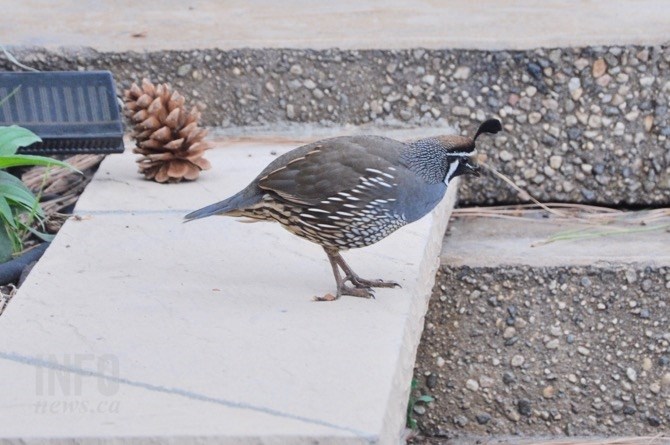
A California quail in an Okanagan back yard. The ubiquitous bird is not native to the valley, originally introduced as a game bird.
(JOHN MCDONALD / iNFOnews.ca)
October 09, 2015 - 4:33 PM
THOMPSON-OKANAGAN - If you ever walk into the middle of a covey of California quail, you will know it instantly by the avian explosion that goes off all around you.
Suddenly birds that never seem to fly, do just that in a panicked whirring of wings, shooting off in every direction.
Yet somehow, 10 minutes later, the covey will have collected itself and again be contentedly pecking the ground for seeds with their distinctive top knots and head-bopping walk, as if their frantic flight to safety had never happened.
“They are precocial creatures which means they can almost instantly run when they are hatched. They have to be able to get away because those tiny little furry balls are prey to all sorts of things, cats, dogs, ravens, magpies, owls,” birder and naturalist Gwyneth Wilson explains.
If you haven’t already, meet the California quail (or callipepla californica) native to the southwestern U.S. as the name suggests but introduced as a game bird in other parts of the world including British Columbia. In Canada, its range is confined largely to the Okanagan where the locals are often surprised to find out the quail isn't a natiive species, but introduced into the province in the 19th century across the province.
You can hunt quail in region 8, the Okanagan, but the big tame flocks that can range throughout the city are off limits. The season is October 1 to November 30 and you're allowed 10 a day, although Wilson says they're not widely sought after.
Credit: Peter Steuart/YouTube
“There’s not much to them but apparently they are good eating although I don’t think anyone hunts them anymore. They brought in other birds for hunting too, the ring-necked pheasant, the grey partridge and a bird called a chuckar from Asia. Those other birds have pretty much disappeared but the quail has adapted well."
Their newborn status as a crunchy snack for all manner of predators means the quail must compensate by having huge broods, 10 to 16 eggs, as many as three times a year, in nests scraped out of the ground.
The highly social quail form large family groups or coveys of 20 or more and can frequently be seen moving as a flock across open or grassy ground, pecking and scratching as they go. The males boldly patterned, with a dark brown cap, black face and throat, a chestnut patch on the belly with a bluish grey breast and speckled flanks with white stripes on the forehead and around the neckline. Females are more muted in colour, mostly grey-brown with a light coloured belly.
Both gender have the comma shaped head plume than arches forward over their faces although the female's plume is much smaller. Quail grow to about 24 to 28 centimetres long.
While they seem to fit right in, California quail are technically an invasive species, first introduced in the Victoria area in 1860 and then in the Lower Mainland about 20 years later. Quail were introduced in Nicola in the Interior in the 1890s but seem to made their way up into the Okanagan from an introduction into Northern Washington.
The Okanagan introduction has been the most successful by far.
They do not migrate in the winter, but instead form even larger coveys, sometimes with hundreds of birds.
“That’s the only thing that wipes them out, is if we have a bad winter,” Wilson says.
If the birds are younger, the parents can often be seen perched on something a few feet in the air, keeping watch over their mottled brown brood, who quickly become experts at concealment.
“They very quickliy learn to run and hide. They like the natural grasslands around here. It’s very similar to their habitat in California. But they love gardens too. They’ve adapted well to an urban setting."
Even if you haven’t seen quail up close, you’ve likely heard the distinctive chi-ca-go call or the quieter pit-pit alarm on walks through the woods.
Wilson says local birders don’t tend to get excited about quail, common as they are, but visitors from outside the Okanagan are usually surprised to see a covey invading a yard or a park en masse.
“People from other parts get all excited. I always do enjoy seeing them. They are not threatened and because they aren’t a native bird, it would never be on a protected list.”
Still, Wilson says no naturalist would discourage interest in any bird, even one as common as the California quail.
“It encourages people to look at all birds and maybe think more about their habitat.”
To contact the reporter for this story, email John McDonald at jmcdonald@infonews.ca or call 250-808-0143. To contact the editor, email mjones@infonews.ca or call 250-718-2724.
News from © iNFOnews, 2015